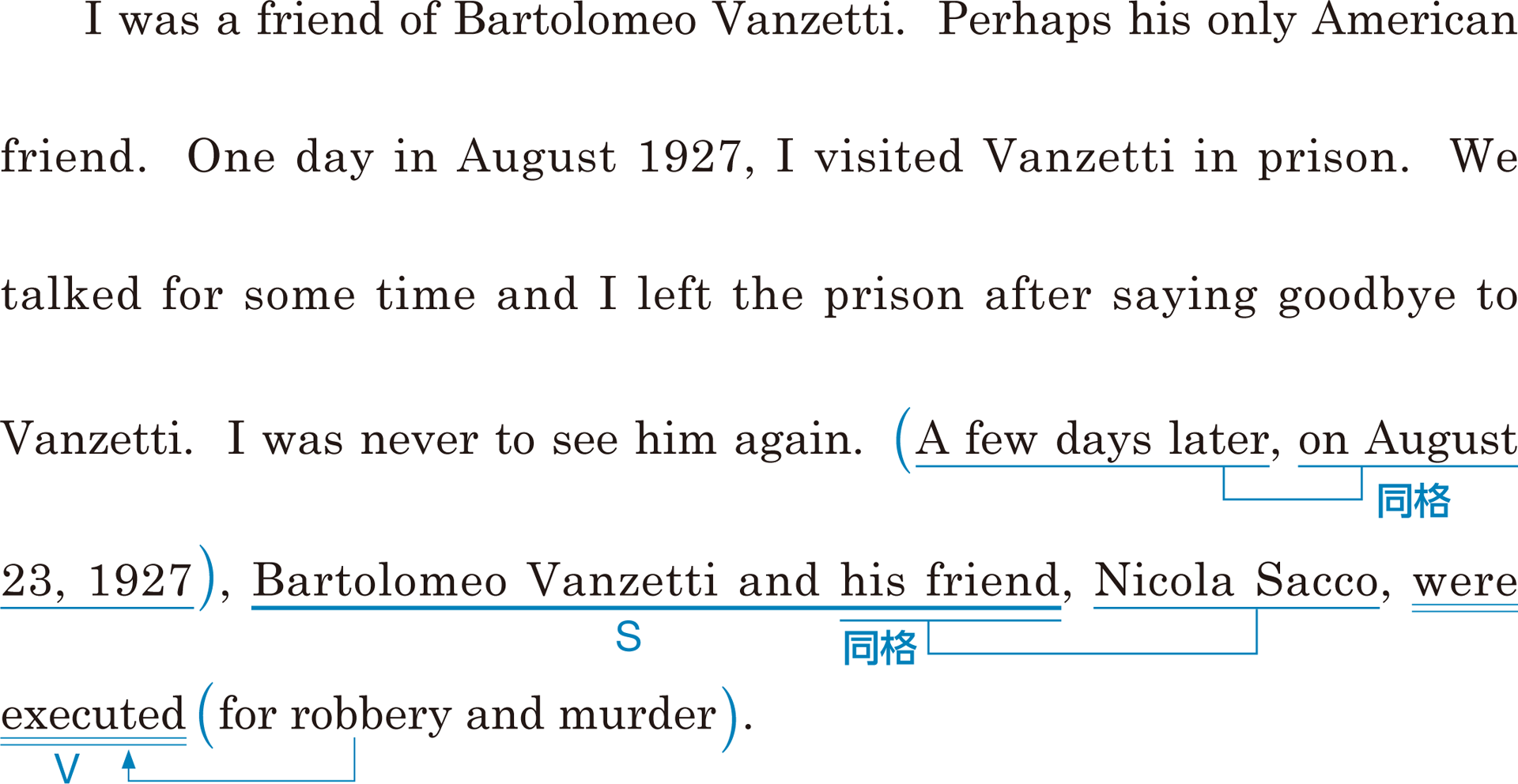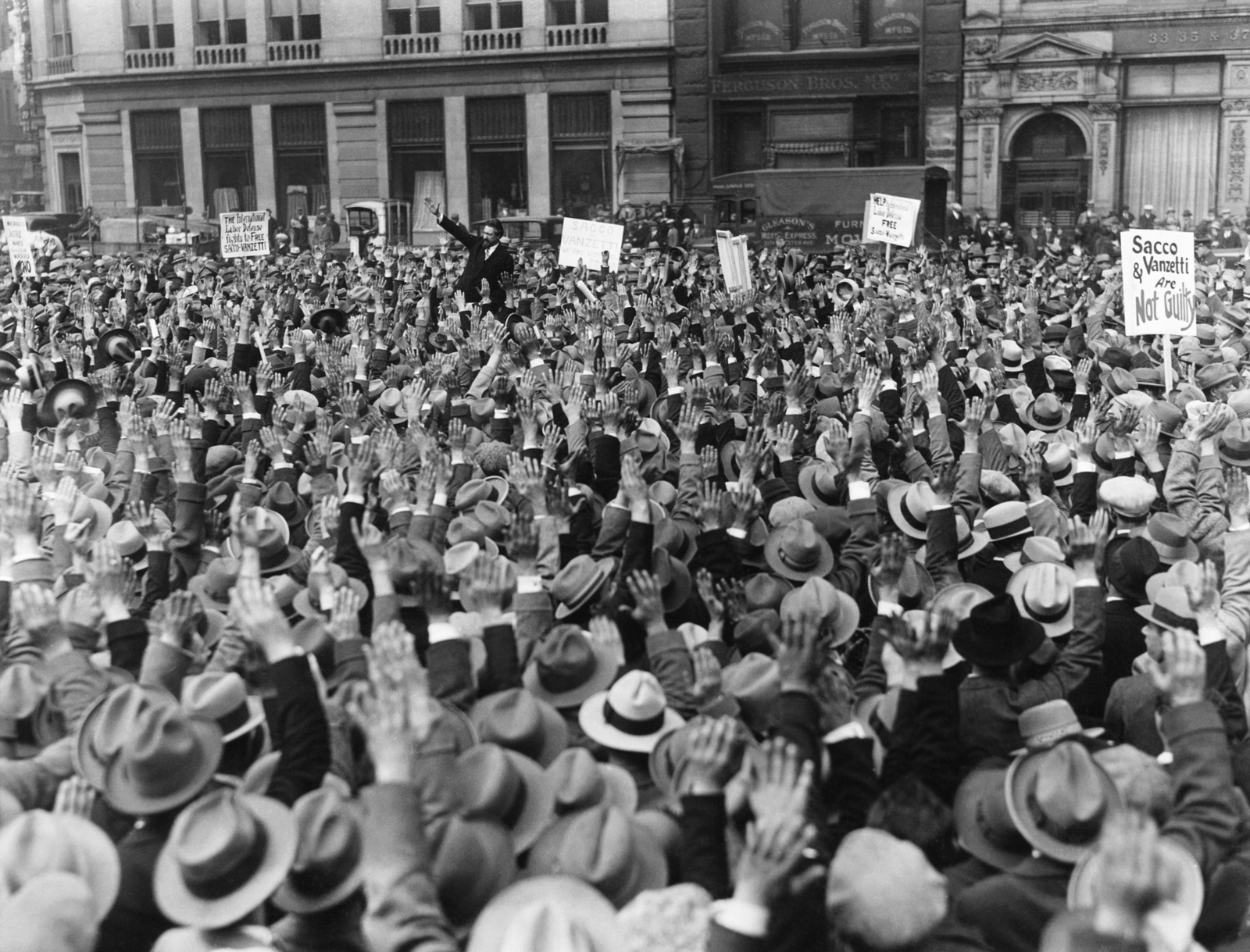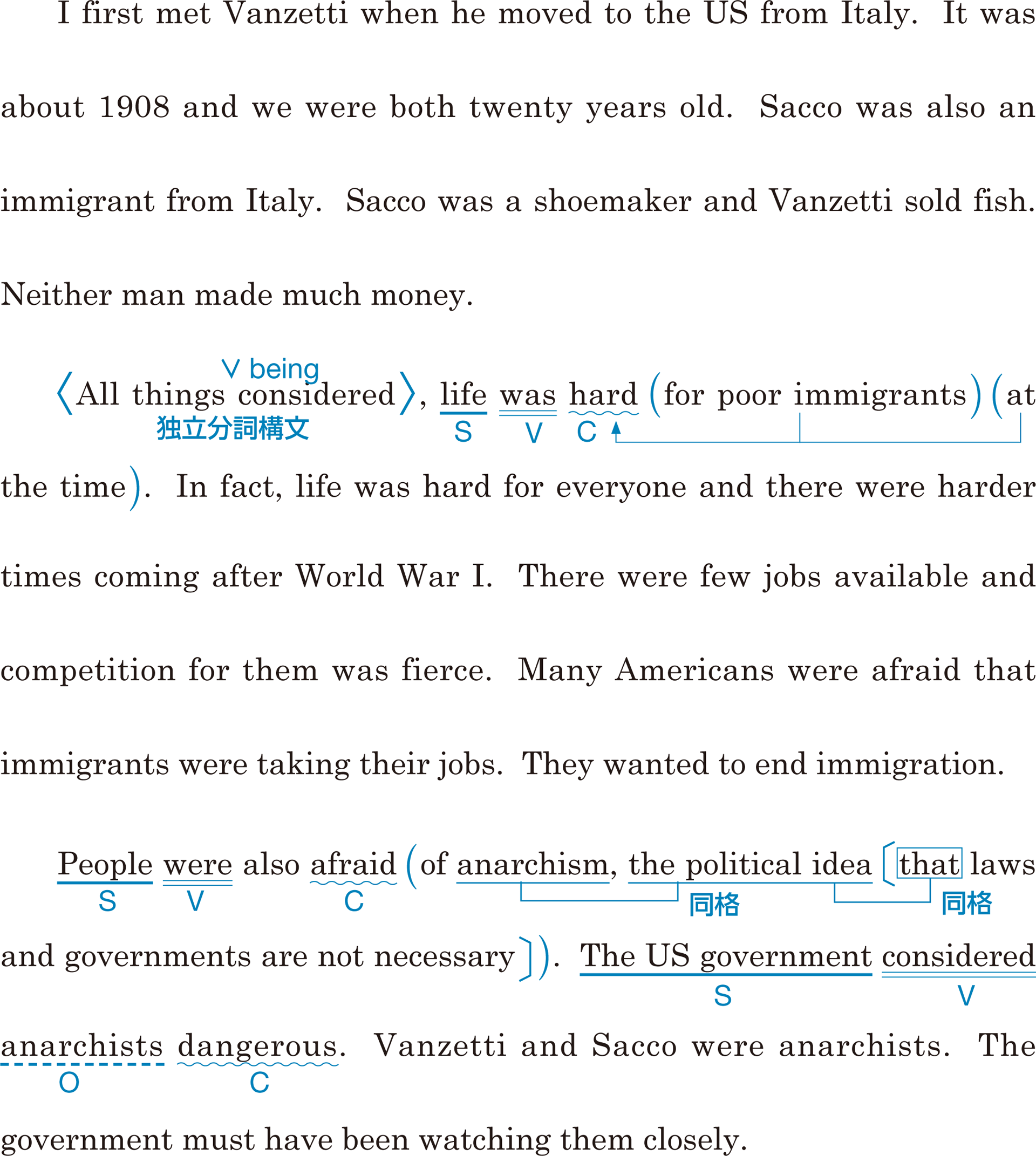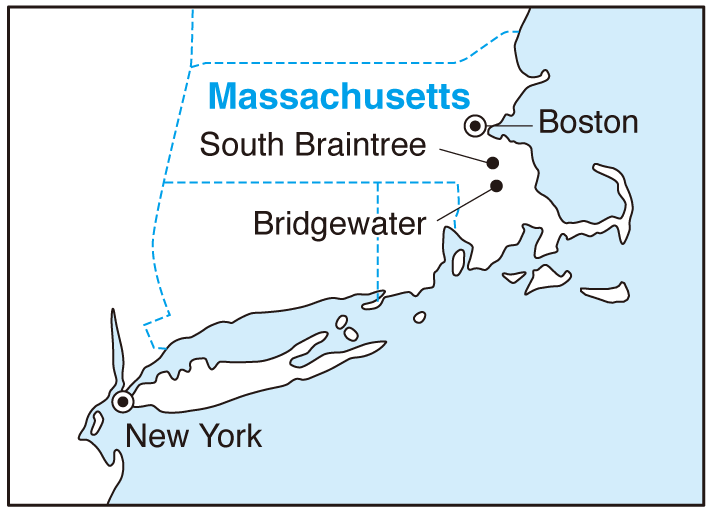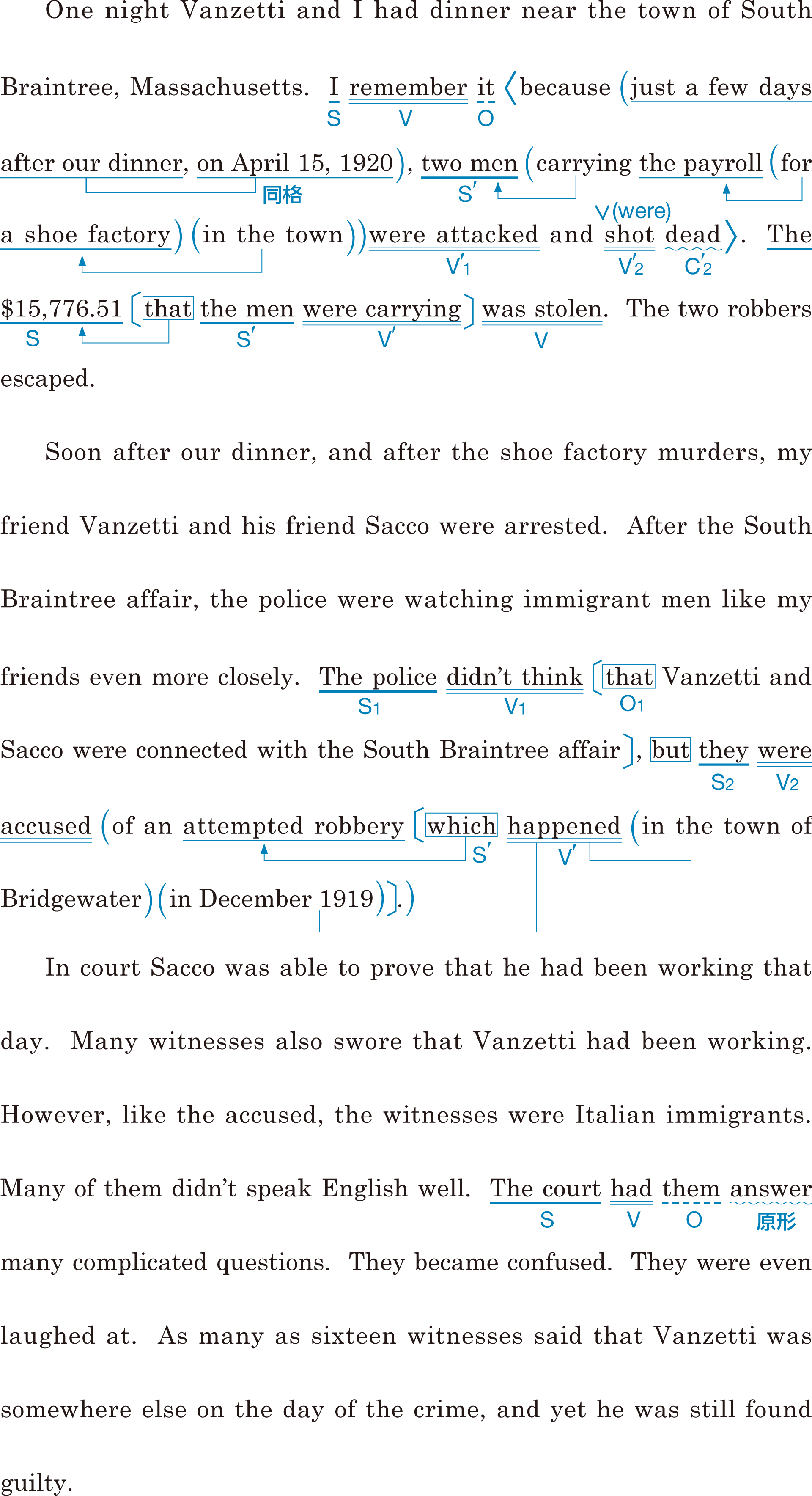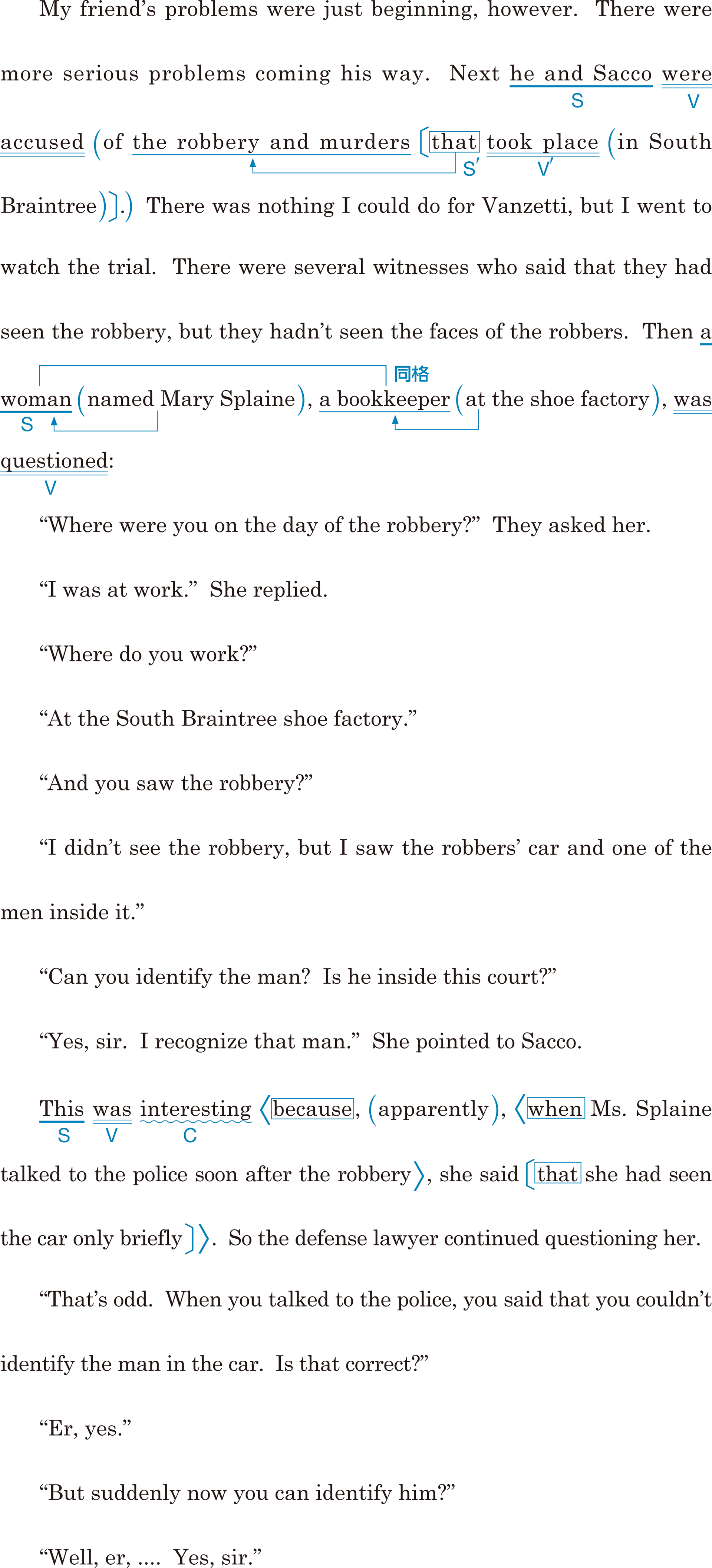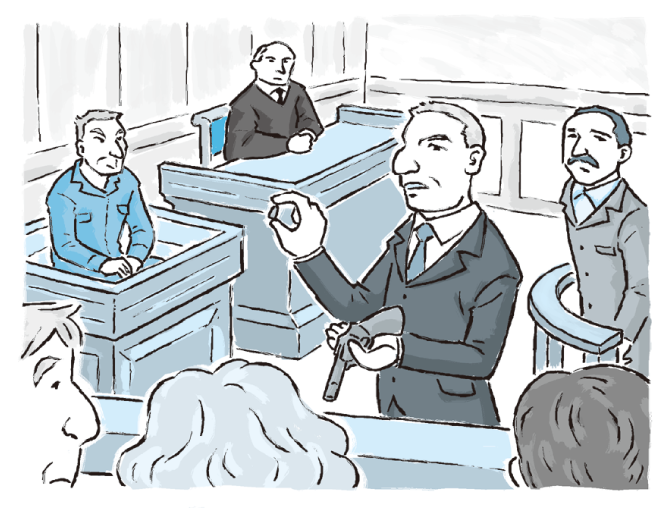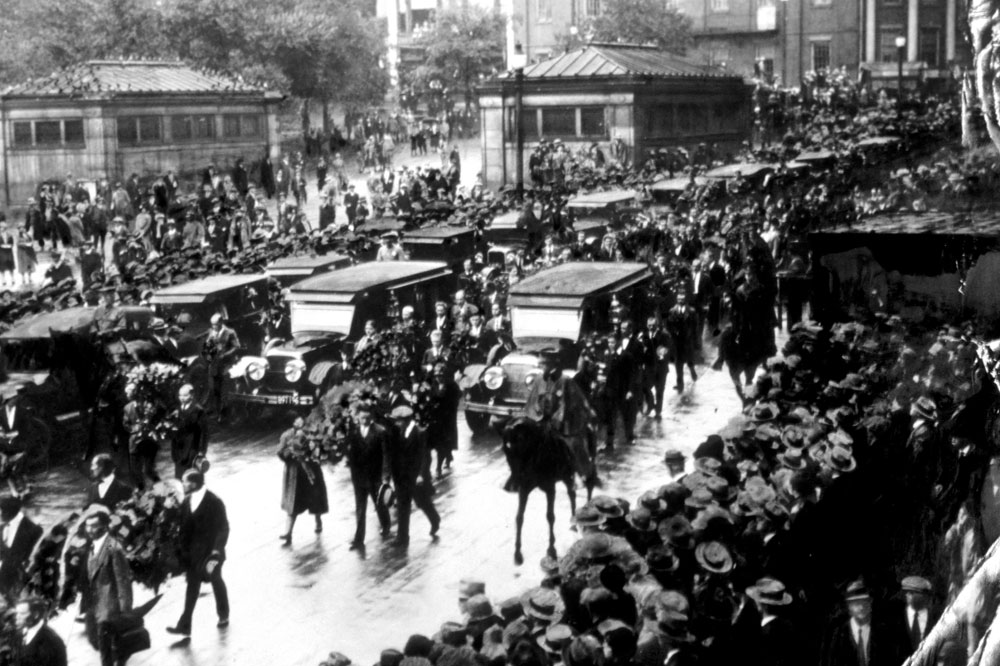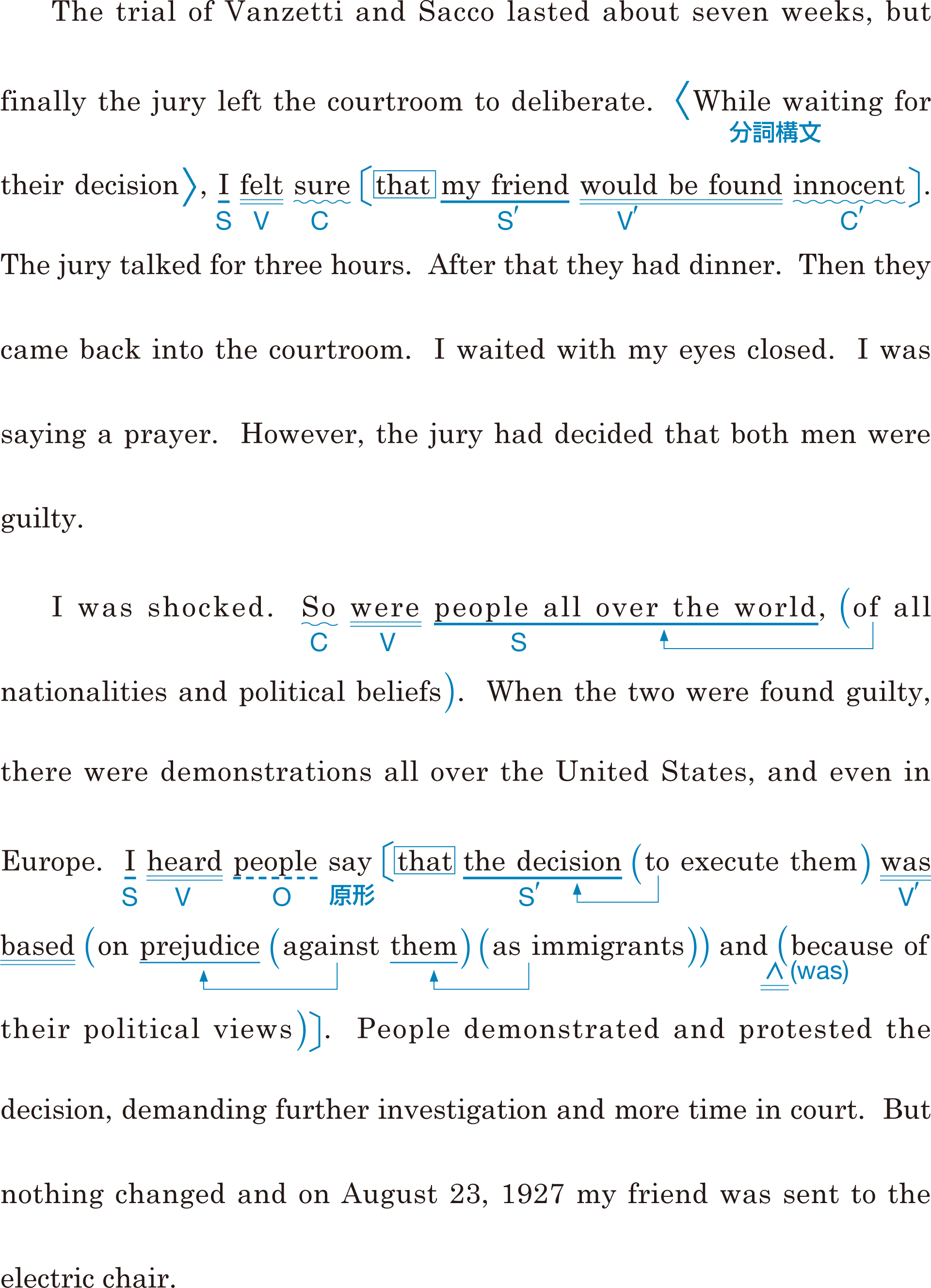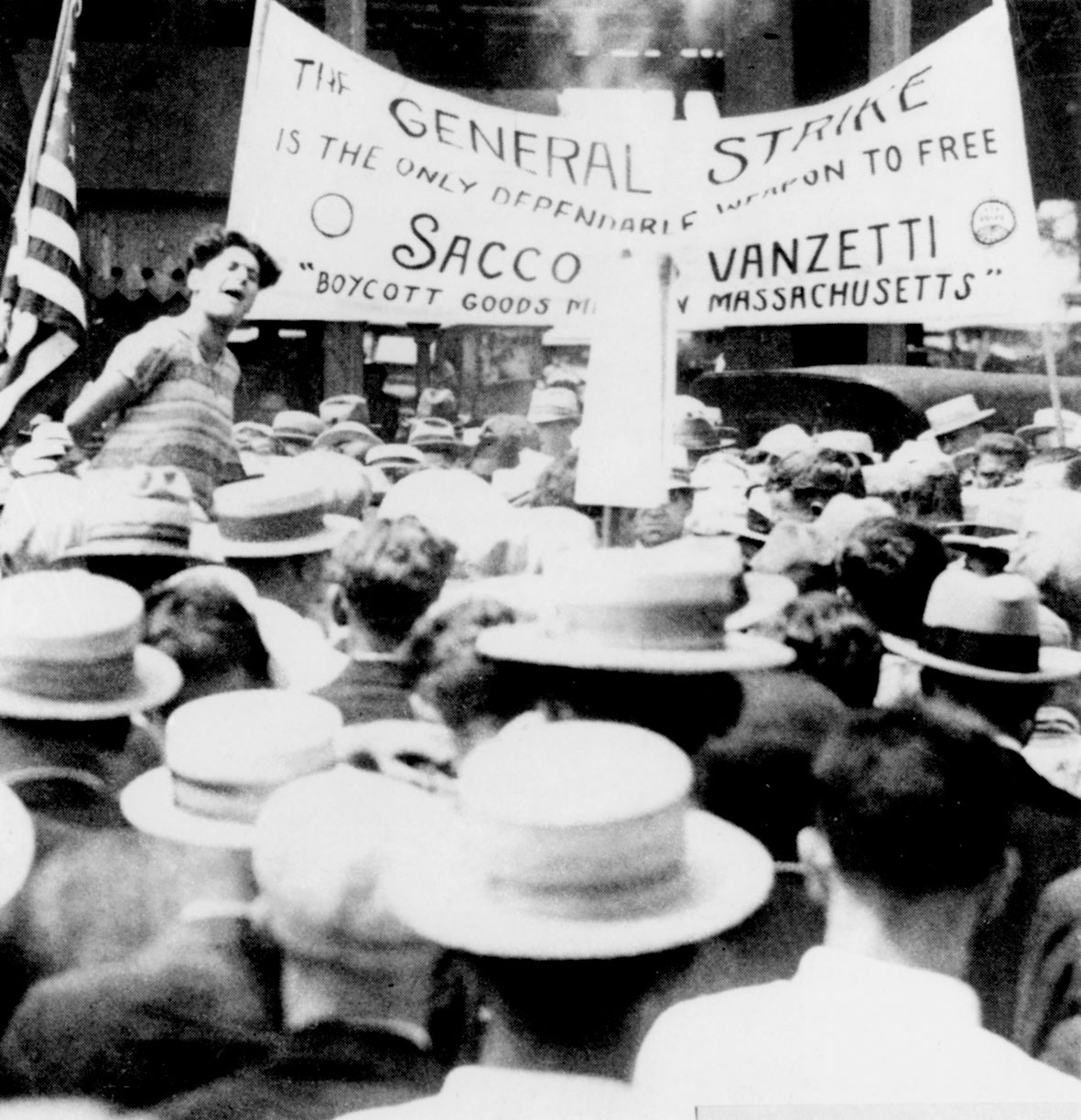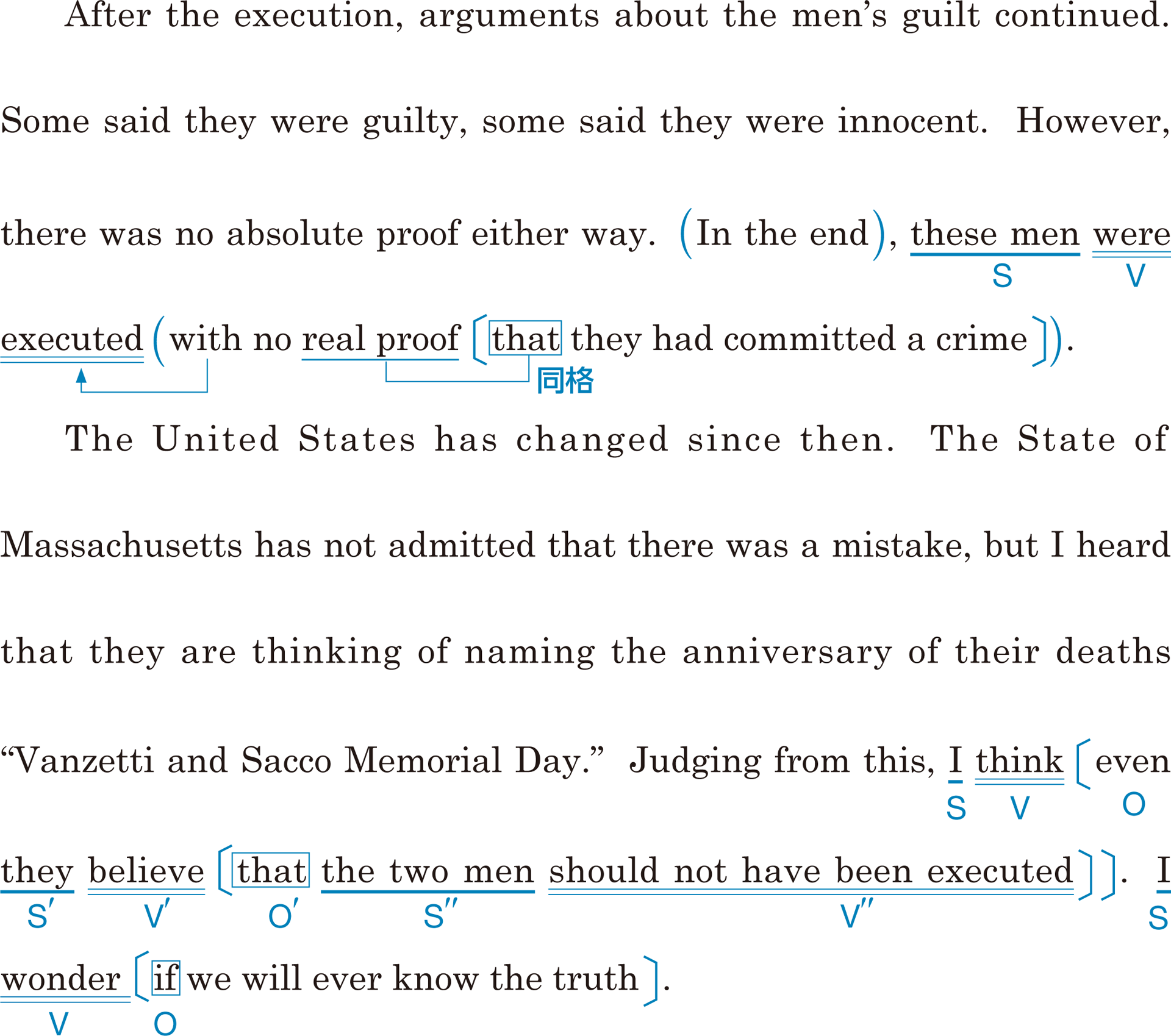READING
Section1
Q What happened on August 23, 1927?

I was a friend of Bartolomeo Vanzetti. Perhaps his only American friend. One day in August 1927, I visited Vanzetti in prison. We talked for some time and I left the prison after saying goodbye to Vanzetti. I was never to see him again. A few days later, on August 23, 1927, Bartolomeo Vanzetti and his friend, Nicola Sacco, were executed for robbery and murder.
私はバートロメオ・ヴァンゼッティの友人でした。おそらく彼のただ 1 人のアメリカ人の友人でした。1927 年 8 月のある日,私は獄中のヴァンゼッティを訪れました。しばらく話をし,ヴァンゼッティに別れを告げたあと,私は刑務所をあとにしました。彼には二度と会えない運命でした。数日後の,1927 年 8 月 23 日,バートロメオ・ヴァンゼッティと彼の友人ニコラ・サッコは強盗および殺人の罪で処刑されたのです。

- Bartolomeo Vanzetti バートロメオ・ヴァンゼッティ
- prison
- goodbye
- Nicola Sacco ニコラ・サッコ
- execute(d)
- robbery

Section 1 : True or False ?

(1) T / F
(2) T / F
(1) Vanzetti had a lot of American friends who encouraged him while he was in prison.[F]
(2) The author saw Vanzetti in prison just a few days before his execution.[T]
Section2
Q Why does the author think the US government was watching Vanzetti and Sacco closely?

I first met Vanzetti when he moved to the US from Italy. It was about 1908 and we were both twenty years old. Sacco was also an immigrant from Italy. Sacco was a shoemaker and Vanzetti sold fish. Neither man made much money.
All things considered, life was hard for poor immigrants at the time. In fact, life was hard for everyone and there were harder times coming after World War I. There were few jobs available and competition for them was fierce. Many Americans were afraid that immigrants were taking their jobs. They wanted to end immigration.
People were also afraid of anarchism, the political idea that laws and governments are not necessary. The US government considered anarchists dangerous. Vanzetti and Sacco were anarchists. The government must have been watching them closely.
私が初めてヴァンゼッティに会ったのは,彼がイタリアからアメリカ合衆国に移住した時でした。それは 1908 年頃で,私たちは 2 人とも 20 歳でした。サッコもまたイタリアからの移民でした。サッコは靴職人で,ヴァンゼッティは魚を売っていました。どちらも稼ぎはたいしてありませんでした。
いろいろな点から考えてみると,当時,貧しい移民たちにとって生活は過酷なものでした。実のところ,誰にとっても生活は厳しく,第一次世界大戦後にはさらに厳しい時代がやって来つつありました。得られる職はほとんどなく,職を得るための競争は激しいものでした。アメリカ人の多くは,移民が自分たちの仕事を奪いつつあるのではないかと恐れていたのです。彼らは外国からの移民を止めたいと思っていました。
人々はまた,無政府主義,すなわち法律や政府は必要ないという政治的な考えも恐れていました。アメリカ合衆国政府は,無政府主義者を危険であるとみなしていました。ヴァンゼッティとサッコは無政府主義者でした。政府当局は彼らを厳重に監視していたに違いありません。

- immigrant
- shoemaker
- fierce
- immigration
- anarchism
- political
- anarchist(s)

Section2 : True or False ?

(1) T / F
(2) T / F
(1) Both Sacco and Vanzetti were making a lot of money in the US.[F]
(2) It was very difficult to get a job in the US after World War I.[T]
Section3
Q What were Vanzetti and Sacco accused of? Were they found guilty?

One night Vanzetti and I had dinner near the town of South Braintree, Massachusetts. I remember it because just a few days after our dinner, on April 15, 1920, two men carrying the payroll for a shoe factory in the town were attacked and shot dead. The $15,776.51 that the men were carrying was stolen. The two robbers escaped.
Soon after our dinner, and after the shoe factory murders, my friend Vanzetti and his friend Sacco were arrested. After the South Braintree affair, the police were watching immigrant men like my friends even more closely. The police didn’t think that Vanzetti and Sacco were connected with the South Braintree affair, but they were accused of an attempted robbery which happened in the town of Bridgewater in December 1919.
In court Sacco was able to prove that he had been working that day. Many witnesses also swore that Vanzetti had been working. However, like the accused, the witnesses were Italian immigrants. Many of them didn’t speak English well. The court had them answer many complicated questions. They became confused. They were even laughed at. As many as sixteen witnesses said that Vanzetti was somewhere else on the day of the crime, and yet he was still found guilty.
ある晩,ヴァンゼッティと私はマサチューセッツ州サウス・ブレイントリーの町の近くで夕食をとりました。私がそれを覚えているのは,ちょうど私たちが夕食をとった数日後の 1920 年 4 月 15 日に,その町のある靴工場の全給料を運んでいた 2 人の男性が襲われて撃ち殺されたからです。その男性たちが運んでいた 15,776 ドル 51 セントは盗まれました。2 人の強盗は逃亡しました。
私たちの夕食から間もなく,そして靴工場の殺人事件のあとに,私の友人ヴァンゼッティと彼の友人サッコは逮捕されました。サウス・ブレイントリー事件のあと,警察は私の友人たちのような移民の男たちをさらに厳重に監視していたのです。警察はヴァンゼッティとサッコがサウス・ブレイントリー事件と関係はないと考えていましたが,彼らは 1919 年 12 月にブリッジウォーターの町で起きた強盗未遂事件で起訴されたのです。
サッコは法廷で,自分がその日はずっと働いていたと証明することができました。たくさんの目撃者たちも,ヴァンゼッティはずっと仕事をしていたと断言しました。しかしながら,起訴された者と同じように,目撃者たちはイタリア人の移民でした。彼らの多くは英語をうまく話せませんでした。裁判官は彼らにたくさんの複雑な質問に答えさせました。彼らは困惑しました。彼らは笑い者にさえされました。16 人もの目撃者たちが,ヴァンゼッティは犯罪の当日にはどこか他の場所にいたと言いましたが,それでもなお彼は有罪を宣告されました。

- South Braintree サウス・ブレイントリー(米国マサチューセッツ州の都市)
- Massachusetts
- payroll
- robber(s)
- affair
- accuse(d)
- attempted
- Bridgewater ブリッジウォーター(米国マサチューセッツ州の都市)
- witness(es)
- swore(< swear)
- accused
- guilty

Section3 : True or False ?

(1) T / F
(2) T / F
(3) T / F
(4) T / F
(1) The two men who were murdered were having dinner in South Braintree.[F]
(2) Sacco had evidence that he had been working on the day of the crime in Bridgewater.[T]
(3) All the witnesses for Vanzetti spoke English very well in court.[F]
(4) Vanzetti was found guilty in spite of having many witnesses to support him.[T]
Section4
Q What more serious trouble did Vanzetti and Sacco get into?

My friend’s problems were just beginning, however. There were more serious problems coming his way. Next he and Sacco were accused of the robbery and murders that took place in South Braintree. There was nothing I could do for Vanzetti, but I went to watch the trial. There were several witnesses who said that they had seen the robbery, but they hadn’t seen the faces of the robbers. Then a woman named Mary Splaine, a bookkeeper at the shoe factory, was questioned:
“Where were you on the day of the robbery?” They asked her.
“I was at work.” She replied.
“Where do you work?”
“At the South Braintree shoe factory.”
“And you saw the robbery?”
“I didn’t see the robbery, but I saw the robbers’ car and one of the men inside it.”
“Can you identify the man? Is he inside this court?”
“Yes, sir. I recognize that man.” She pointed to Sacco.
This was interesting because, apparently, when Ms. Splaine talked to the police soon after the robbery, she said that she had seen the car only briefly. So the defense lawyer continued questioning her.
“That’s odd. When you talked to the police, you said that you couldn’t identify the man in the car. Is that correct?”
“Er, yes.”
“But suddenly now you can identify him?”
“Well, er, .... Yes, sir.”
ところが,私の友人の災難は始まったばかりでした。さらに深刻な問題が彼に降りかかりつつあったのです。次に,彼とサッコはサウス・ブレイントリーで起きた強盗と殺人で起訴されました。ヴァンゼッティのために私ができることは何もありませんでしたが,私は裁判を見に行きました。その強盗事件を見たと言う目撃者が何人かいましたが,彼らは強盗たちの顔は見ていなかったのです。それから靴工場の帳簿係でメアリー・スプレインという名前の女性が尋問されました。
「強盗事件の日にあなたはどこにいましたか?」彼らは彼女にたずねました。
「私は仕事をしていました」と彼女は答えました。
「あなたはどこで仕事をしていますか?」
「サウス・ブレイントリー靴工場です。」
「それであなたは強盗事件を目撃しましたか?」
「私は強盗事件は見ませんでしたが,強盗たちの自動車と,その中にいた男たちのうち 1 人を見ました。」
「あなたはその男を特定できますか? 彼はこの法廷の中にいますか?」
「ええ。あの男に見覚えがあります。」彼女はサッコを指さしました。
これは興味深いことでした。というのも,どうやら,強盗事件の直後にスプレインさんが警察に話した時には,彼女はその自動車をほんのちらっとだけ見たと言ったらしいからです。そこで被告側の弁護士が彼女に対する質問を続けました。
「それはおかしいですね。警察と話をした時,あなたは自動車の中の男が誰かわからないと言いました。そうですね?」
「ええと,はい。」
「しかし突然今はその男が誰かわかるのですか?」
「あの,ええと,…はい。」

- come one’s way
- take place
- Splaine
- bookkeeper
- at work
- identify
- apparently
- briefly
- defense
- odd

Section4 : True or False ?

(1) T / F
(2) T / F
(3) T / F
(4) T / F
(1) Vanzetti and Sacco were set free after the trial for the Bridgewater murders.[F]
(2) Some witnesses saw the faces of the South Braintree robbers clearly.[F]
(3) Ms. Splaine was working at the shoe factory on the day of the robbery.[T]
(4) Ms. Splaine told the police that she couldn’t identify the man in the robbers’ car at first.[T]
Section5
Q Did the author think the cap and bullets were absolute evidence that Vanzetti and Sacco were guilty? Why?

Another important piece of evidence was a cap. A cap had been found near the place where the murders had taken place. It was said to be Sacco’s cap. However, when Sacco tried on the cap in court, it was too small for him! Amazingly, the lawyer for the prosecution ignored this fact and continued to talk about “Sacco’s cap.” Even though the jury could see that the cap was too small, they heard the phrase “Sacco’s cap” over and over again.
Next, the prosecution asked a witness named James Bostock, who sometimes worked at the shoe factory, several questions.
“Did you see the men who fired the gunshots?” They asked him.
“Not properly,” he replied. “But they appeared to be foreigners.”
“What do you mean?”
“Well, they kind of looked like Italians, sir.”
They asked him if he recognized Vanzetti and Sacco, but he said no.
James Bostock had picked up some bullets from the scene of the murder. Now I knew Vanzetti had a gun. His gun was brought into court and they compared the bullets. They were different!
もう 1 つの重要な証拠は縁なし帽でした。殺人事件が起こった場所の近くで 1 つの縁なし帽が見つかっていたのです。それはサッコの帽子だと言われました。しかし,サッコが法廷でその帽子をかぶってみると,それは彼には小さすぎたのです! 驚いたことに,検察側の弁護士はこの事実を無視して「サッコの帽子」について話し続けました。陪審員団はその帽子は小さすぎるとわかっていたけれども,彼らは「サッコの帽子」という言い回しを何度も繰り返し聞いたのです。
次に検察側は,ジェームズ・ボストックという名前の目撃者に──彼は時々靴工場で働いていましたが──いくつか質問をしました。
「あなたは銃弾を発射した男たちを見ましたか?」と彼らは彼にたずねました。
「まともに見たわけではありません」と彼は答えました。「しかし,彼らは外国人のように見えました。」
「どういうことですか?」
「ええと,彼らはどちらかというとイタリア人のように見えました。」
検察側は彼に,ヴァンゼッティとサッコに見覚えがあるかたずねましたが,彼はないと言いました。
ジェームズ・ボストックは殺人現場から何発かの銃弾を拾ってきていました。その時,私はヴァンゼッティが銃を持っていることを知りました。彼の銃が法廷に持ち込まれ,彼らは銃弾を比較しました。それらは違っていたのです!

- evidence
- amazingly
- prosecution
- jury
- Bostock
- gunshot(s)
- foreigner(s)
- kind of どちらかというと
- bullet(s)
- compare(d)

Section5 : True or False ?

(1) T / F
(2) T / F
(1) The lawyer for the prosecution used the phrase “Sacco’s cap” in front of the jury again and again.[T]
(2) James Bostock said that the men who fired the gunshots looked like Italians.[T]
Section6
Q What decision did the jury reach about Vanzetti and Sacco?

The trial of Vanzetti and Sacco lasted about seven weeks, but finally the jury left the courtroom to deliberate. While waiting for their decision, I felt sure that my friend would be found innocent. The jury talked for three hours. After that they had dinner. Then they came back into the courtroom. I waited with my eyes closed. I was saying a prayer. However, the jury had decided that both men were guilty.
I was shocked. So were people all over the world, of all nationalities and political beliefs. When the two were found guilty, there were demonstrations all over the United States, and even in Europe. I heard people say that the decision to execute them was based on prejudice against them as immigrants and because of their political views. People demonstrated and protested the decision, demanding further investigation and more time in court. But nothing changed and on August 23, 1927 my friend was sent to the electric chair.
ヴァンゼッティとサッコの裁判はおよそ 7 週間続きましたが,ようやく陪審員団が審議するために法廷を退席しました。彼らの評決を待っている間,私は友人が無罪になるだろうと確信していました。陪審員団は 3 時間協議しました。その後,彼らは食事をとりました。それから彼らは法廷に戻ってきました。私は目を閉じて待ちました。私はお祈りを唱えていました。しかしながら,陪審員団は彼らが 2 人とも有罪であると決めていたのです。
私は衝撃を受けました。世界中の,あらゆる国籍や政治的信念を持つ人々も同じでした。2 人が有罪判決を受けた時,アメリカ合衆国全土で,またヨーロッパでもデモが起こりました。私は,彼らを死刑にする判決は,移民としての彼らに対する偏見に基づくものであり,彼らの政治的な考えによるものだと人々が口にするのを聞きました。人々はデモを行って判決に抗議し,さらなる調査や法廷でもっと時間を費やすことを求めました。しかし,何も変わることはなく,1927 年 8 月 23 日に私の友人は電気イスに送られたのです。

- courtroom
- deliberate
- nationality, nationalities
- prejudice
- demonstrate(d)
- further
- investigation

Section6 : True or False ?

(1) T / F
(2) T / F
(1) There were demonstrations against the decision even in Europe.[T]
(2) People demanded that further investigation of the murders be made.[T]
Section7
Q Why was there still a lot of disagreement about the execution of Vanzetti and Sacco?

After the execution, arguments about the men’s guilt continued. Some said they were guilty, some said they were innocent. However, there was no absolute proof either way. In the end, these men were executed with no real proof that they had committed a crime.
The United States has changed since then. The State of Massachusetts has not admitted that there was a mistake, but I heard that they are thinking of naming the anniversary of their deaths “Vanzetti and Sacco Memorial Day.” Judging from this, I think even they believe that the two men should not have been executed. I wonder if we will ever know the truth.
処刑のあと,男たちの有罪についての議論は続きました。彼らが有罪だと言う人もいれば,無実だと言う人もいました。しかし,どちらにしても決定的な証拠はなかったのです。結局彼らは,罪を犯したという確かな証拠がないまま処刑されたのです。
その時から,アメリカ合衆国は変化を遂げてきました。マサチューセッツ州は過ちがあったことを認めてはいませんが,州当局が彼らの命日を「ヴァンゼッティとサッコ追悼記念日」に指定しようと考えていると聞きました。このことから判断すると,私は州当局ですら 2 人の男たちが処刑されるべきではなかったと確信していると思うのです。私たちはいったい真実を知ることになるのでしょうか。

- execution
- argument(s)
- guilt
- absolute
- proof
- commit(ted)
- admit(ted)
- anniversary
- memorial
- judging from

Section7 : True or False ?

(1) T / F
(2) T / F
(1) After the execution, evidence was found proving that Vanzetti and Sacco were not guilty.[F]
(2) The author believes Vanzetti and Sacco should have been executed.[F]

